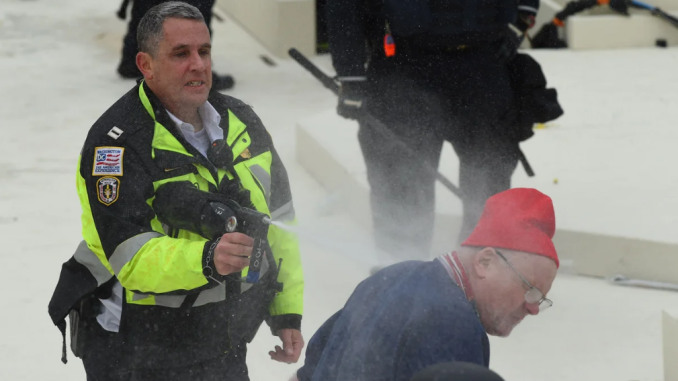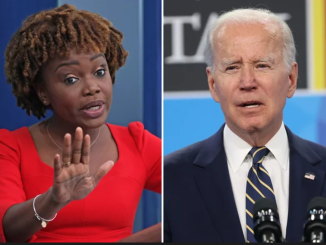
The District of Columbia Metropolitan Police Department refused to provide Blaze News with copies of the Use of Force Incident Reports from its massive presence at the U.S. Capitol on Jan. 6, 2021.
{snip}
‘No, you’re going to kill her!’
Under MPD policy, the department had until June 2 to provide a response to the Blaze News request, but failed to do so until June 10.
“Your request was considered,” wrote MPD FOIA specialist Shania Hughes in a letter to Blaze News.
“A review of our records determined the information you seek is law enforcement sensitive and not for public release.”
Hughes’ letter cited §2-534(a)(4) of the Code of the District of Columbia, which states:
The following matters may be exempt from disclosure under the provisions of this subchapter: Inter-agency or intra-agency memorandums or letters, including memorandums or letters generated or received by the staff or members of the Council, which would not be available by law to a party other than a public body in litigation with the public body.
The D.C. Code makes no mention of the subjective and nebulous term “law enforcement sensitive.”
{snip}
Blaze News filed another FOIA request with MPD on May 1, seeking a record of all Jan. 6 use-of-force complaints. The department returned a spreadsheet listing a single complaint having to do with “shoving.”
Jacqueline Hazzan, legal counsel for the MPD Office of Police Complaints, said the details of that complaint would not be released because they would “reveal information about the agency’s internal deliberative process before it was completed” and “cause an unwarranted invasion of others’ personal privacy.”
{snip}
‘It wasn’t until I saw the video that I realized how bad it was.’
Metropolitan Police routinely refuse to release any bodycam footage from Jan. 6. Former Jan. 6 defendants have posted a large cache of MPD bodycam video, but the department practice has been that the public is not allowed access to Jan. 6 video.
Blaze News covered a high-impact use-of-force case in the point-blank shooting of Pennsylvania dump-truck driver Mark Griffin with a 40mm shell filled with hard rubber baton rounds. The shot — fired by an officer, according to video — split Griffin’s left femur from top to bottom. The injury required several surgical procedures to repair, including insertion of a titanium plate with 14 screws.
{snip}
Other prominent Jan. 6 use-of-force cases included the beating of protester Rosanne Boyland by MPD Officer Lila Morris. Boyland had collapsed at the mouth of the Lower West Terrace Tunnel and appeared to be lifeless when Morris used a wooden walking stick to strike Boyland in the face, head, and ribs, according to video evidence.
It is unknown the extent of injuries Boyland suffered as a result. Third-party video and bodycam footage showed that Boyland was bleeding from her right eye and her nose. There was a visible injury above her right eye that was not mentioned or documented by paramedics, the emergency room physician, or the Office of the Chief Medical Examiner in its autopsy report.
{snip}
Bagshaw had ‘gone hands-on with demonstrators in Washington for years.’
The Epoch Times filed a FOIA request for Officer Morris’ Jan. 6 bodycam footage, but MPD refused to grant access, saying releasing the video would violate Morris’ privacy.
Protester Victoria C. White of Rochester, Minn., was beaten in the head, neck, and face by then-Lt. Jason Bagshaw and other officers inside the Lower West Terrace tunnel about 20 minutes before Boyland collapsed, video showed. Capitol Police CCTV security video and MPD bodycam footage showed that White was struck nearly 40 times with steel riot batons and fists.
At 4:11 p.m., a bystander at the tunnel mouth repeatedly tried to intervene to protect White. He shouted at police, “No, no, no, no. Please … please don’t beat her!” and “No, you’re going to kill her!” according to the bodycam of MPD Officer Andrew Wayte. In one violent series, Bagshaw repeatedly pummeled White in the side of the face with a closed fist, security video showed.
{snip}
The lawsuit said White was subjected to “objectively unreasonable, excessive, and indeed, deadly force that shocks the conscience.”
Bagshaw has been with MPD for more than 22 years. A July 2022 article in the Washington Post said Bagshaw has “gone hands-on with demonstrators in Washington for years, winning colleagues’ respect but drawing criticism from demonstrators.” The article did not mention Bagshaw’s actions against White in the tunnel on Jan. 6. Bagshaw was promoted to commander in April 2022.
The FBI began collecting use-of-force data from law enforcement agencies nationwide on Jan. 1, 2019. Of 18,514 federal, state, local, and tribal law enforcement agencies nationwide, 5,481 reported use-of-force data to the FBI. Participation in the National Use-of-Force Data Collection is encouraged, but not mandatory.
Both MPD and the Metro Transit Police Department supply use-of-force data to the FBI, according to the FBI Crime Data Explorer.
{snip}
In 2024, the primary uses of force reported included firearms, hands/fists/feet, canine, and electronic control weapons such as a taser, according to the database. Police uses of force were a response to failure to comply with verbal commands, attempt to escape or flee from custody, using a firearm against an officer or other person, displaying a weapon at an officer, and resisting being handcuffed or arrested, the FBI reported.
* Original Article:
https://www.theblaze.com/news/metropolitan-police-department-refuses-public-access-to-jan-6-use-of-force-reports


